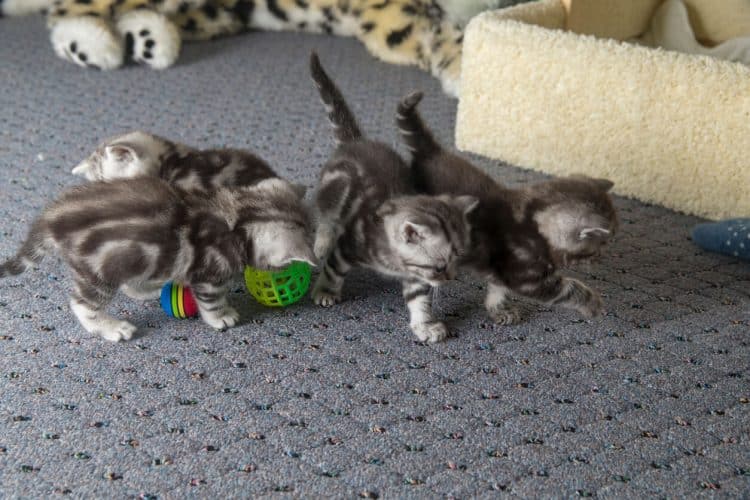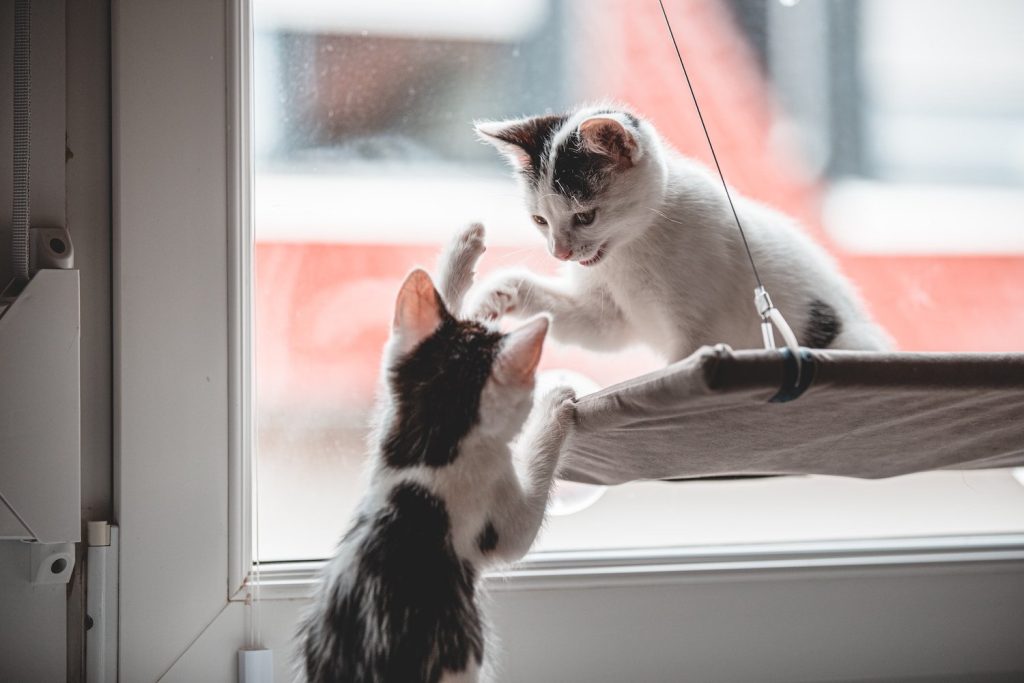There are a lot of things that a kitten has to get used to. These include unfamiliar smells and noises or strange people and other animals. How to interact your cat and about cat socialization, you can read here.
Bringing a feline into your own home is extremely exciting for animals and people. This applies not only to the new cat owner, but also to the cat itself, which first has to get used to its new home, strangers and everyday life.
How good those kitty’s ability to get along with its family and other animals in the future depends on how well it is interacted. But what does that actually mean exactly? How and at what age is a cat interacted? Is interacting older cats also possible?
Table of Contents
What does the term “socialization” mean?
In general, the term socialization describes the process of getting used to the community and adopting certain behavioral requirements. The kitty must learn that it can trust its new family and that it does not have to be afraid of strangers or animals. She learns that small children are loud from time to time, that household appliances make loud noises and that driving in one transport box is not bad. She learns where to eat, as she does cat litter box used and how far it can go when playing and running around. In the best case scenario, the cat gets to know all of these things in its first three months of life. In order for the cat to appear relaxed in the future, it is important that the animal comes into contact with several people, animals, noises and smells from an early age. It is also important that these encounters are as positive as possible.

Socializing a cat: Why is socialization important?
If a cat has not been properly interacted, the animal may later exhibit behavioral problems. They react very shyly and become quick anxious and nervous and kicking often aggressive . While some behavior is still harmless, such as sucking on the pillow, other peculiarities can make life together more difficult. Things become difficult when the cat scratches furniture and walls or leaves urine on the carpet. This also applies if the cat shows its claws during play or bites when strangers want to pet it. Extensive intermingling is therefore essential for a harmonious and stress-free coexistence between humans and cats. Not only does this benefit the owner, but also the animal itself, which will go through life in a friendly and relaxed manner.
The foundations of socialization are laid in the first months of life
How a cat’s personality develops later also depends on its environment and experiences. The first three months of life, more precisely the period between the fourth and the twelfth week of life, are particularly formative. The experiences that the little cat collects during this formative phase are stored firmly in the brain and have a major influence on later life. In the best case scenario, the cat is still in the care of its mother during this time. The mother cat plays a very important role in the intermingling of her kitten.
The role of the cat mother
Responsible breeders give their kittens should be born at the earliest when they are 12 weeks old and leave them close to their mother until then. The mother is the kittens’ most important caregiver and role model in the first few weeks. The kitten learns how to interact with her siblings and people and adopts this behavior. If the mother cat is relaxed with her human owners, she lets herself be petted and occasionally seeks their proximity. This means that your young will soon gain trust in the two-legged friends. Also the kitten training is initially carried out by the mother cat. While playing with her siblings, the mother shows the little cat how far she can go. If she bites or scratches too hard, the mother cat intervenes and naturally sets her limits.

Socializing Cats: The Breeder’s Responsibility
For the familiarization of the kittens, it is important that the mother cat is also properly interacted. If you want to buy a kitten from a breeder, you should pay attention to how the mother behaves. If the mother reacts shyly or aggressively, runs away to the farthest corner or hisses, she passes this behavior on to her young. When the cat moves away from the letting the breeder companion animal you and looking at the visitor with curiosity suggests that the cats are growing up in a species-appropriate environment.
How can I help my cat settle in?
Separating from the mother cat and moving into a new home means a big change for the little cat. Of course, she first has to get used to the strange surroundings, the people, the smells and noises. The better she is interacted by her cat mother and the breeder, the easier it will be for her to get involved in the new and unknown. However, this does not mean that only the breeder and the mother cat should interact the cat. Although the foundations are laid in the first weeks of life, familiarization can and should continue even after the twelfth week of life. Now the responsibility is in your hands and you, as its new owner, can do a lot to make the start of its new life easier for your cat.
Five helpful tips for your kitten
- Offer your kitten a safe place to retreat
Even if the young kitten is so curious, sometimes the many new impressions are simply too much for her. Then it is important that she can retreat to a safe place where she can have peace and process the experiences. Even before the cat moves in, you should think about where this place could be. A basket with one soft blanket in a quiet corner of your home is ideal. You should also provide hiding places and places at height, as many cats feel safer on elevated levels. This can be done, for example be a scratching and climbing post . You can also place a cat blanket on a windowsill or a safe shelf.
If your cat is already used to the transport box, you can leave it in the room initially. This means she can escape in there at any time if she ever gets frightened. A large, upside-down box with a small opening and a soft blanket inside is also a popular hiding place.
- Leave it to your kitten to start
When interacting your cat, you should exercise a high level of patience. This also applies to getting used to it. It is important that you never pressure your cat or force it to do anything. Never drag them out of their safe hiding place just because your visitor wants to pet the new kitten. Respect if your new animal roommate feels the need for peace and quiet and would prefer to withdraw first. A cat doesn’t become tame just because it’s constantly being picked up! Instead, go about your normal activities apartment and signal to her just by your presence that you are there and that she can come to you if she wants. At some point your cat’s curiosity will get the better of him and he will venture out of hiding on his own.
- Get at eye level
To take away the shyness of cats, it is helpful to get up to eye level with them. This will make you appear less threatening and will make it easier for your cat to approach you and be petted. For example, just make yourself comfortable on the floor in front of the sofa. Sit on the carpet or blanket, read a book, listen to the radio, or watch (quiet) television. When the cat approaches, first let it sniff your hand and then stroke its back and cheeks in slow movements. Honor your cat’s every approach with praise, gentle petting or even a small one treat and show her that you are happy to be near her.
- Show your kitten a lot of new things – without overwhelming her
In the first few months of life, you should show your cat lots of new things such as music, cars and other people and animals. This should help the cat lose its natural distrust. However, you shouldn’t overdo it. Finally, your cat also needs time to process the new impressions. Be patient and introduce your cat to new things carefully. Watch your cat closely and leave him alone if he signals that he is nervous. Once she has trusted you and your family and rubs against your leg while purring, she is certainly ready for strangers to visit. Invite young and old over so that your cat learns that people are different. However, a huge party with lots of people in a small space and loud music would initially be overwhelming.
- Stay calm and be patient
Just as not all people are the same, cats are not all the same. While some cats are very open-minded, others are naturally more fearful. Respect your cat’s individuality and be patient if it doesn’t work straight away. After just a few weeks, some cats have completely gotten used to their new surroundings, their new family and their everyday life. However, other cats need two months or longer to slowly gain trust. If you treat the cat lovingly without harassing it, yelling at it, or getting annoyed when it hides or makes a mistake, it will come out of its cover.

Can you socialize an adult cat?
Unfortunately, not every cat is lucky enough to be raised in an environment that values their familiarization right from the start. Some cats will after the separated from their mother at birth too early, they grow up without contact with their siblings and are on their own from the start. The older the cat is and the worse its experiences, the more difficult it is for it to regain trust.
Older cats may still be interacted, but this requires a lot of time and patience. But if you give the cat the time and space to withdraw and always treat it lovingly, you will eventually notice that the cat will slowly open up on its own. Once the ice is broken, older cats often become particularly cuddly and very affectionate.
Socialize your cat: Patience pays off
Being patient will definitely pay off when interacting your cat. Don’t expect your cat to be able to do everything right from the start, to let anyone love him or to get along well with children and other animals straight away. Proceed carefully and allow them to arrive slowly in their new home.
For example, if you bring other pets together , it makes sense to initially keep them in separate rooms. You should first try to get closer by smelling each other. Let your dog or older cat sniff the “new one’s” transport box. Give the new cat one of the other’s toys or blankets to smell. Associate the smell with something positive – for example by placing the object near it, place food bowls. The animals slowly come closer to each other through their noses and realize that the other person poses no danger.
We wish you and your cat a successful and relaxed start!
FAQs
Q: What is socializing a kitten?
A: Socializing a cat is the process of introducing and familiarizing the kitten with human interaction, as well as other animals and environments, to ensure it grows up to be well-adjusted and comfortable in various social settings.
Q: Why is it important to socialize a kitty?
A: Interacting a cat is important to help the cat develop healthy social behavior and reduce the likelihood of fear or aggression towards people, other animals, and new experiences as it grows older.
Q: When should I start socializing my young cat?
A: It’s best to start interacting a cat as early as possible, ideally between 2 to 7 weeks of age, as this is the critical period for social development in cats.
Q: How can I interact a cat that is feral or shy?
A: Socializing a feral or shy cat may require patience and gradual exposure to positive experiences with humans, such as gentle handling, play, and treats, in a calm and secure environment.
Q: What are some signs of familiarization within a kitten?
A: Signs of familiarization within a kitten include their comfort around humans, willingness to interact and play, and absence of fearful or aggressive behavior in new situations.
Q: How can I introduce a new kitten to my other pets?
A: When introducing a new kitten to other pets, it’s important to do so gradually and under supervision, allowing the animals to become familiar with each other’s scents and gradually interact in a controlled manner.
Q: What are some effective ways to reward social behavior in kittens?
A: You can reward social behavior in kittens by offering them treats, verbal praise, and interactive play sessions as positive reinforcement for their desired social interactions.
Q: What are the benefits of interacting kittens in a foster home?
A: Interacting kittens in a foster home environment allows them to experience human interaction, other animals, and various stimuli in a safe and nurturing setting, which can greatly contribute to their social development.
Q: Can adult cats also be interacted?
A: While it may take more time and patience compared to interacting kittens, adult cats can also be interacted to feel more comfortable around people and other animals through gradual and positive exposure to new experiences and environments.
Q: How can I help my cat adjust to outdoor homes?
A: If you plan to allow your cat to spend time outdoors, it’s important to familiarize them with the environment gradually, providing them with safe and secure outdoor spaces and ensuring they remain comfortable and confident in their outdoor surroundings.